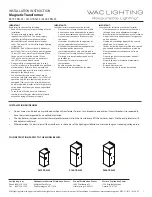
2
LINKS1000 GLOSSARY OF TERMS
The following is a description of various terms used with regards to cellular technology.
Electronic Serial Number (ESN)
The ESN is the unique serial number of a cellular phone. It is used by the cellular network to track calls
and increment billing. The ESN is stored at the time of manufacture and cannot be reprogrammed. This
number, in either hexadecimal or decimal, must be loaded into the database of the cellular carrier before
service can begin. The ESN can be found on the shipping box and on the heat sink of the LINKS1000 board.
Cellular Phone Number and Area Code
A 10 digit number (3 digit area code and 7 digit directory number ) identifying the cellular telephone. Do not
enter the phone number of the central monitoring station as the cellular phone number when programming the
LINKS1000.
Initial Paging Channel
A three digit number that specifies which ‘Side’ carrier you have contracted for service. Each cellular service
area only has two sides, A or B. The initial paging channel for Side A is ‘333’ and for Side B is ‘334’.
System ID
Also called the Home Access ID, this 5 digit number identifies the customer's predefined ‘Home System’. This
number refers to a geographic area and is used by the cellular carrier to determine if the unit is ‘Home’ or in
‘Roam’.
Access Overload Class
This is the number that specifies the level of priority of the cellular call. There is no correlation between this
number and the level of cellular service unless there is a network emergency.
Group Identification Mark
This number is factory programmed and specifies how many bits of the System ID are compared when
processing signals. The Group Mark ID for LINKS1000 is set at 10. This number will make the LINKS1000
compatible with all North American networks.
Preferred System Mark
This number is determined by the Initial Paging Channel and refers to which system, A or B, is scanned for
first.
Roam/Roaming
Using cellular service outside of one ‘Home’ area. Usage charges are higher when Roaming.





































